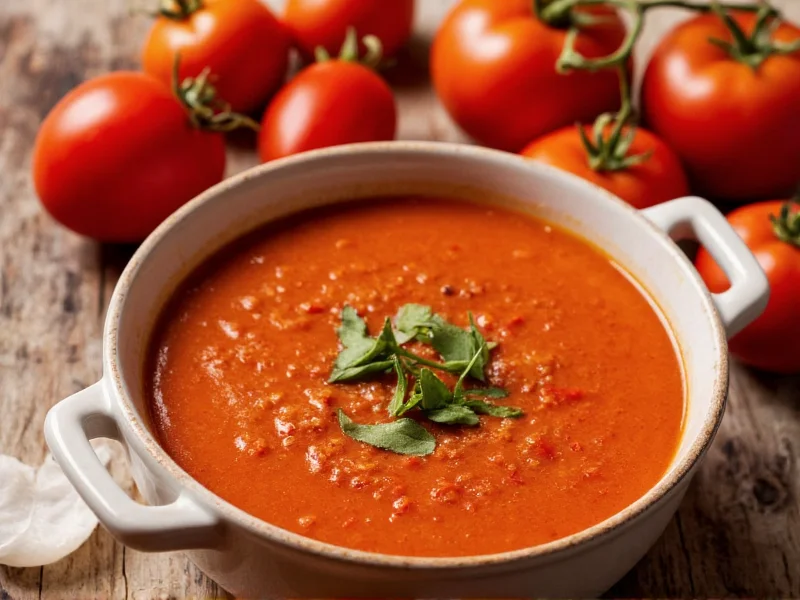Making tomato soup from fresh tomatoes transforms a simple pantry staple into a vibrant seasonal delight. Unlike canned alternatives, fresh tomato soup captures the essence of summer produce at its peak. This guide provides everything you need to create restaurant-quality tomato soup from garden-fresh or farmers' market tomatoes, including variety selection, preparation techniques, and flavor-enhancing tips that prevent common pitfalls like watery consistency or bland taste.
Why Fresh Tomatoes Outperform Canned for Soup
While canned tomatoes offer convenience, fresh tomatoes provide distinct advantages when making soup from scratch. The flavor profile of vine-ripened tomatoes contains complex sugars and acids that canned versions often lack due to processing. Fresh tomatoes also retain more vitamin C and lycopene in their natural state. When selecting tomatoes specifically for how to make tomato soup from fresh tomatoes, choose varieties with high flesh-to-liquid ratio to prevent watery results.
Best Tomato Varieties for Soup
Not all tomatoes work equally well in soup. The ideal varieties balance acidity, sweetness, and flesh density:
| Tomato Variety | Flavor Profile | Best For |
|---|---|---|
| Roma (Plum) | Low moisture, meaty flesh | Classic thick tomato soup base |
| San Marzano | Sweet with mild acidity | Smooth, balanced flavor profiles |
| Beefsteak | Juicy with robust flavor | Combining with meatier varieties |
| Cherry | Intensely sweet | Adding depth to other varieties |
For the best tomatoes for tomato soup, select fully ripe specimens with deep color and slight give when gently squeezed. Avoid refrigeration before use, as cold temperatures degrade flavor compounds. Peak season tomatoes (July-September in most climates) contain up to 30% more natural sugars than off-season varieties, creating richer flavor without added sweeteners.
Essential Equipment for Fresh Tomato Soup
You don't need specialized equipment for homemade tomato soup from garden tomatoes, but these tools make the process more efficient:
- Heavy-bottomed pot (prevents scorching during long simmering)
- Immersion blender (safest for hot liquids compared to countertop blenders)
- Food mill (removes skins and seeds while maintaining smooth texture)
- Sharp paring knife (for efficient tomato preparation)
Step-by-Step Fresh Tomato Soup Recipe
This fresh tomato soup recipe without cream serves 4 and takes 45 minutes from start to finish:
Ingredients
- 2.5 lbs ripe tomatoes (Roma or San Marzano preferred)
- 1 medium yellow onion, diced
- 3 garlic cloves, minced
- 2 tbsp olive oil
- 1 tsp sugar (optional, balances acidity)
- 1 tbsp tomato paste (enhances umami)
- 2 cups vegetable broth
- 1 fresh basil sprig
- Salt and pepper to taste
Preparation
- Prepare tomatoes: Score an "X" on the bottom of each tomato. Blanch in boiling water for 30 seconds, then transfer to ice water. Skins should peel off easily. This how to peel tomatoes for soup method preserves flesh integrity.
- Sauté aromatics: Heat olive oil over medium heat. Cook onions until translucent (5-7 minutes), then add garlic and tomato paste, stirring for 1 minute until fragrant.
- Build flavor base: Add peeled tomatoes, sugar, broth, and basil. Bring to gentle simmer.
- Simmer: Cook uncovered for 25-30 minutes, stirring occasionally, until tomatoes break down completely and liquid reduces by one-third.
- Blend and refine: Remove basil. Use immersion blender to puree soup directly in pot. For ultra-smooth texture, pass through food mill to remove any remaining seeds or skin fragments.
- Season: Adjust salt, pepper, and acidity with lemon juice if needed. The soup should have bright but balanced flavor.
Avoiding Common Fresh Tomato Soup Mistakes
Many easy fresh tomato soup for beginners attempts fail due to preventable errors:
- Using unripe tomatoes: Underripe tomatoes lack sufficient natural sugars, resulting in overly acidic soup. If your tomatoes aren't perfectly ripe, add 1/2 tsp sugar during cooking.
- Over-blending hot soup: Blending hot liquids in countertop blenders can cause dangerous steam explosions. Always cool slightly or use an immersion blender.
- Skipping the reduction step: Fresh tomatoes contain more water than canned. Simmering uncovered concentrates flavor and prevents watery results.
- Overcooking herbs: Add delicate herbs like basil at the end to preserve their bright flavor notes.
Serving Suggestions and Variations
Enhance your seasonal tomato soup recipe with these professional touches:
- Classic pairing: Serve with grilled cheese sandwiches using sharp cheddar and sourdough bread
- Vegan option: Top with coconut cream swirl and fresh basil instead of dairy
- Flavor boost: Add a Parmesan rind during simmering for umami depth (remove before blending)
- Texture contrast: Garnish with homemade croutons or pumpkin seeds
Storage and Reheating Guidelines
Proper storage maintains the fresh quality of your soup:
- Refrigeration: Store in airtight container for up to 4 days. The flavor often improves after 24 hours as ingredients meld.
- Freezing: Freeze in portion-sized containers for up to 3 months. Leave 1-inch headspace for expansion.
- Reheating: Warm gently over medium-low heat, stirring frequently. Avoid boiling which can cause separation.
- Reviving: Add a splash of broth or water when reheating to restore ideal consistency.











 浙公网安备
33010002000092号
浙公网安备
33010002000092号 浙B2-20120091-4
浙B2-20120091-4